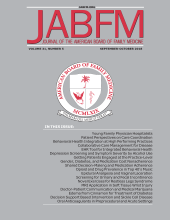Abstract
Introduction: Primary care providers (PCPs) account for half of opioid prescriptions, often feel chronic pain patients are challenging to manage, and there is wide variability in practice patterns. The purpose of this pilot study was to evaluate the impact of a previsit pharmacist review of high-risk patients treated with opioids for chronic pain on compliance to guideline recommendations at a family medicine residency clinic.
Methods: All adult patients with an appointment for chronic pain who were prescribed >50 morphine milligram equivalents (MMEs)/day had charts reviewed by a pharmacist before each appointment; recommendations were sent electronically to the provider before the appointment. After 4 months of implementation, each patient's chart was manually reviewed to gather outcome variables. The primary outcomes were the mean MMEs/day and pain scores.
Results: Pharmacist previsit recommendations were provided for 45 patients. When comparing outcomes before and after intervention, the mean MMEs/day decreased by 14% (P < .001), with no change in pain scores (P = .783). Statistically significant improvements were noted in multiple other secondary opioid safety outcomes.
Conclusion: Clinical pharmacists providing previsit recommendations was associated with decreased opioid utilization with no corresponding increase in pain scores and increased compliance to guideline recommendations.







